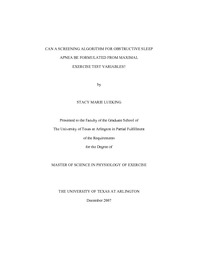
ATTENTION: The works hosted here are being migrated to a new repository that will consolidate resources, improve discoverability, and better show UTA's research impact on the global community. We will update authors as the migration progresses. Please see MavMatrix for more information.
Show simple item record
| dc.contributor.author | Lueking, Stacy Marie | en_US |
| dc.date.accessioned | 2008-04-22T02:41:23Z | |
| dc.date.available | 2008-04-22T02:41:23Z | |
| dc.date.issued | 2008-04-22T02:41:23Z | |
| dc.date.submitted | December 2007 | en_US |
| dc.identifier.other | DISS-1947 | en_US |
| dc.identifier.uri | http://hdl.handle.net/10106/753 | |
| dc.description.abstract | Purpose: The primary purpose of this study was to compare the cardiopulmonary and electrocardiography exercise testing responses of overweight individuals between one group, at low-risk (LR) for developing OSA, versus another group at high-risk (HR) for developing OSA. Methods: Both men (N = 11) and women (N = 11) participated in the study (age 37.00 ± 12.55 yrs., BMI 35.61 ± 6.43). Each subject was assigned to one of two groups, LR (AHI ≤ 5) or HR (AHI > 5) depending upon their overnight AHI score from the ApneaLink® sleep report. In the LR (age 30.45 ± 8.40 yrs., BMI 34.93 ± 5.66, AHI 1.82 ± 1.47) group, there were 2 males and 9 females and in the HR (age 43.55 ± 12.89, BMI 36.30 ± 7.34, AHI 26.10 ± 18.80) group there were 6 males and 5 females. Each Independent t-tests were used to analyze vi difference between the LR and HR groups. Significance was set at .05. Results: Regression analysis revealed that the combination of neck circumference, age, and four minute recovery rate pressure product (RPP) explained 76 percent of the variance in risk indicator (RI) observed in results from the sleep recording taken from the ApneaLink. Similarly, neck circumference, age, four minute recovery RPP, and peak ventilation (VEpk) explained 82 percent of the variance in apnea-hypopnea index (AHI). Conclusion: Exercise markers in combination with neck circumference and age, may be helpful in the initial detection of obstructive sleep apnea (OSA). This may help detect those who may benefit from an expensive polysomnography (PSG) test for OSA diagnosis. These preliminary results suggest that the value of a graded exercise test (GXT) to assess the performance of those with undiagnosed OSA. | en_US |
| dc.description.sponsorship | Blevins-McNaughton, Jennifer | en_US |
| dc.language.iso | EN | en_US |
| dc.publisher | Kinesiology | en_US |
| dc.title | Can A Screening Algorithm For Obstructive Sleep Apnea Be Formulated From Maximal Exercise Test Variables? | en_US |
| dc.type | M.S. | en_US |
| dc.contributor.committeeChair | Blevins-McNaughton, Jennifer | en_US |
| dc.degree.department | Kinesiology | en_US |
| dc.degree.discipline | Kinesiology | en_US |
| dc.degree.grantor | University of Texas at Arlington | en_US |
| dc.degree.level | masters | en_US |
| dc.degree.name | M.S. | en_US |
Files in this item
- Name:
- umi-uta-1947.pdf
- Size:
- 1.895Mb
- Format:
- PDF
This item appears in the following Collection(s)
Show simple item record


